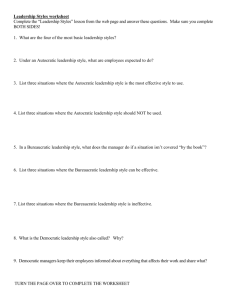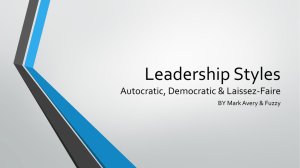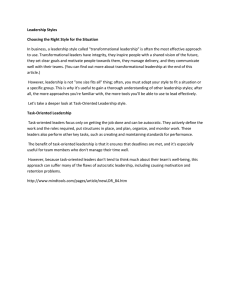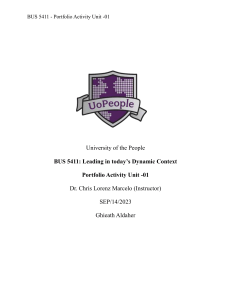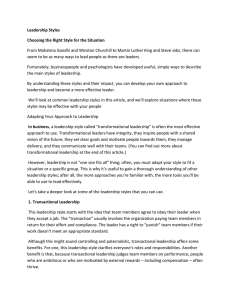Leadership Dr Tabassum Alvi Assistant Professor Psychiatry/Behavioural sciences Majmaah University
advertisement
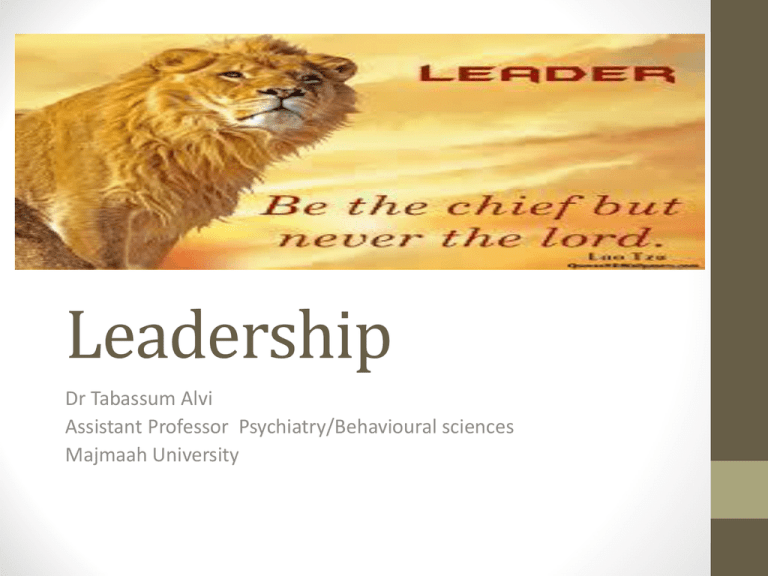
Leadership Dr Tabassum Alvi Assistant Professor Psychiatry/Behavioural sciences Majmaah University Objectives • At the end of the session the student should be able to : a) b) c) d) Define ‘Leadership’ Explain why leadership is important Describe the characteristics of a good leader Differentiate the types of leadership What is Leadership • An important characteristic of a good leader is the ability to explore personal and team motives/beliefs in accomplishing a change or perceived vision of success. • As part of this process true leadership requires the ability to critically appraise the team process and outcomes on the path to achieving a shared goal. Leadership Importance of leadership in Medicine Clinicians should have an insight into leadership styles and responsibilities in order; • To gain a deeper understanding of the attributes required of being a doctor. • Supporting, ‘leaders’ within the organization. Leadership roles in health care • • • • Teaching Inspiring confidence Empowering Improving performance – supporting reflection/clinical supervision • Rewarding and recognizing individual contributions • Recognizing the needs of the service from clinically based environment Leadership roles in health care • Leading and developing services – implementing change • Supporting the organization and when necessary, providing a bridge between senior management and team members/employees in informing, supporting and developing national agreed initiatives. Characteristics of a good leader • Leaders have a key role as ‘change agents’ and role models. • As a Change agents can be described as requiring six skills to manage change effectively (Dale et al., 2002) 1. The ability to work independently, without the power, sanction and support of the management hierarchy. 2. The skills of an effective collaborator, able to compete in ways that enhance rather than destroy co-operation. 3. The ability to develop high trust relationships, based on high ethical standards. 4. Self-confidence, tempered with humility. 5. Respect for the process of change, as well as the content. 6. The ability to work across business functions and units, to be ‘multi-faceted and ambidextrous’. Leadership responsibilities Leadership responsibilities include awareness of; • One’s own abilities (strengths and weaknesses) • Level of authority • Needs of the patient group • The needs of the individual employees and the ‘team’. Types Of Leadership Autocratic Leadership • The autocratic leader is given the power to make decisions alone, having total authority. • They stand in master of the people and impose their wills and no one is allowed to challenge them. • This is the style used by the Catholic Church for example, dictators and monarchs. Autocratic Leadership • Pros :This leadership style seems to be good for employees that need close supervision or new untrained people to perform certain tasks. • Con : Creative employees and team players resent this type of leadership, since they are unable to enhance processes or decision making, resulting in job dissatisfaction Transformational leadership • The transformation leader motivates its team to be effective and efficient. • Communication is the base for goal achievement focusing the group in the final desired outcome or goal attainment. • This leader is highly visible and uses chain of command to get the job done. • Transformational leaders focus on the big picture, needing to be surrounded by people who take care of the details. • The leader is always looking for ideas that move the organization to reach the vision Bureaucratic leadership • The bureaucratic leader believes more in very structured procedures. • Tends to bend over the pre-established measures rather it was successful or not. • This type of leadership has no space to explore new ways to solve problems • Usually slow paced to ensure adherence to the ladders stated by the company. • Leaders ensure that all the steps have been followed prior to sending it to the next level of authority. Bureaucratic leadership • Pros : Universities, hospitals, banks and government usually require this type of leader in their organizations to ensure quality, increase security and decrease corruption. • Con : Leaders who would like to speed up the process will experience, their frustration and anxiety and are not welcomed Charismatic leadership • The charismatic leader leads by infusing energy and eagerness into their team members. • She/he is not someone who feels pleased with any type of stationary situation. • This type of leader has to be committed to the organization for the long run. • If the success of the project is attributed to the leader and not the team, charismatic leaders may become a risk for the company by deciding to resign for advanced opportunities. • It takes a company, time and hard work to gain the employees confidence back with other type of leadership after they have committed themselves to the magnetism of a charismatic leader. Democratic leadership • The democratic leader listens to the team’s ideas and studies them, but hold the responsibility to make the final decision. • Team players contribute to the final decision therefore increasing people satisfaction and ownership, feeling their input was considered when the final decision was taken. • When changes arises, this type of leadership helps the team assimilate the changes better and more rapidly than other styles, knowing they were consulted and contributed to the decision making process, minimizing resistance and intolerance. • A shortcoming of this leadership style is that it has difficulty when decisions are needed in a short period of time or at the moment. Laissez-faire leadership • The laissez-faire leader gives no continuous feedback or supervision because the employees are highly experienced and need little supervision to obtain the expected outcome. • This type of style is also associated with leaders that don’t lead at all, failing in supervising team members, resulting in lack of control and higher costs, bad service or failure to meet deadlines. • In government this is what the type of leadership which may drive to anarchy People-oriented leadership • The people-oriented leader is the one that, in order to comply with effectiveness and efficiency, supports, trains and develops his personnel, increasing job satisfaction and genuine interest to do a good job Servant leadership • The servant leader facilitates goal accomplishment by giving its team members what they need in order to be productive. • This leader is an instrument, employees use to reach the goal rather than a commanding voice that moves to change. • This leadership style, in a manner similar to democratic leadership, tends to achieve the results in a slower time frame. Task-oriented leadership • The task-oriented leader focuses on the job, and concentrates on the specific tasks assigned to each employee to reach goal accomplishment. • This leadership style suffers the same motivational issues as autocratic leadership, showing no involvement in the teams needs. • It requires close supervision and control to achieve expected results (Fiedler,1967). • Another name for this is deal maker and is linked to a first phase in managing change, enhance, according to the “organize with chaos” approach Environmental leadership • The environmental leader is the one who nurtures group or organizational environment to affect the emotional and psychological perception of an individual’s place in that group or organization. • An understanding and application of group psychology and dynamics is essential for this style to be effective. • The leader uses organizational culture to inspire individuals and develop leaders at all levels. • This leadership style relies on creating an education atmosphere where groups interactively learn the fundamental psychology of group dynamics and culture from each other. • The leader uses this psychology, and complementary Thank you

